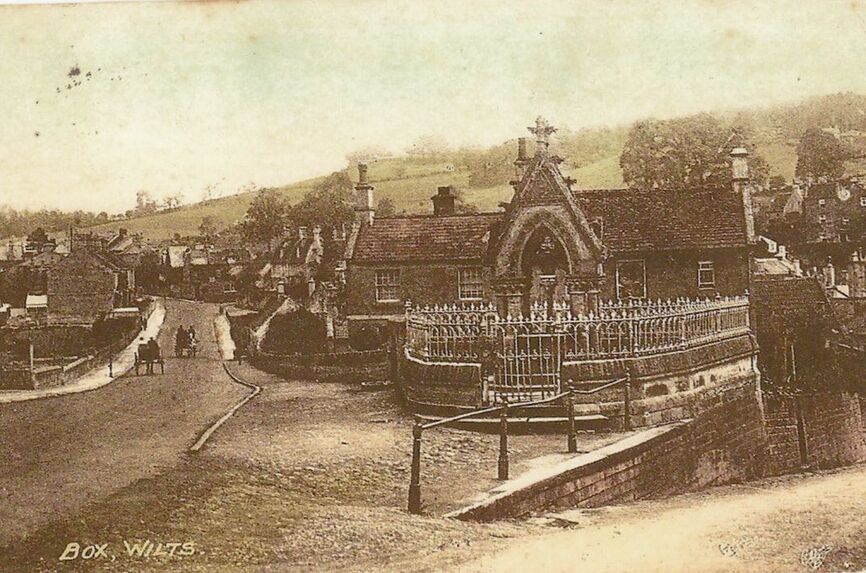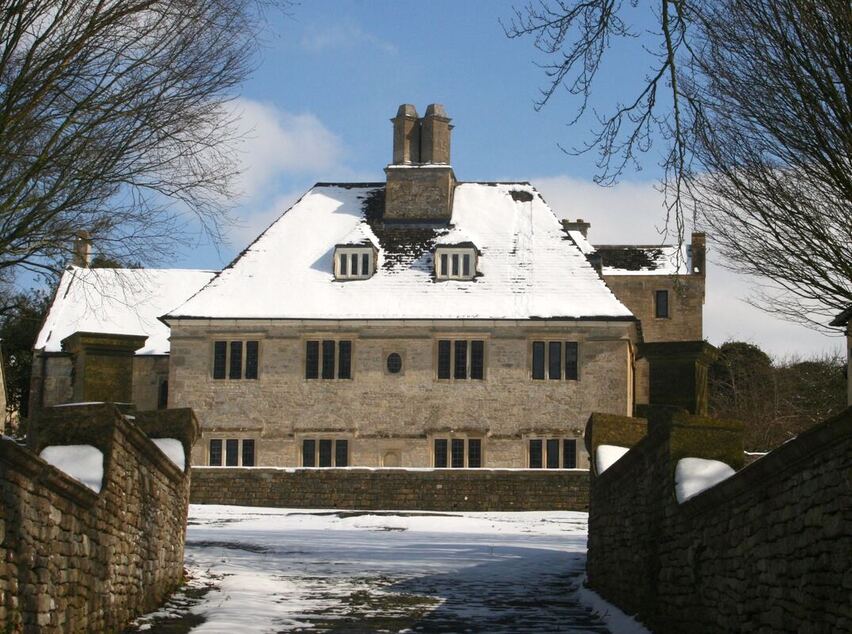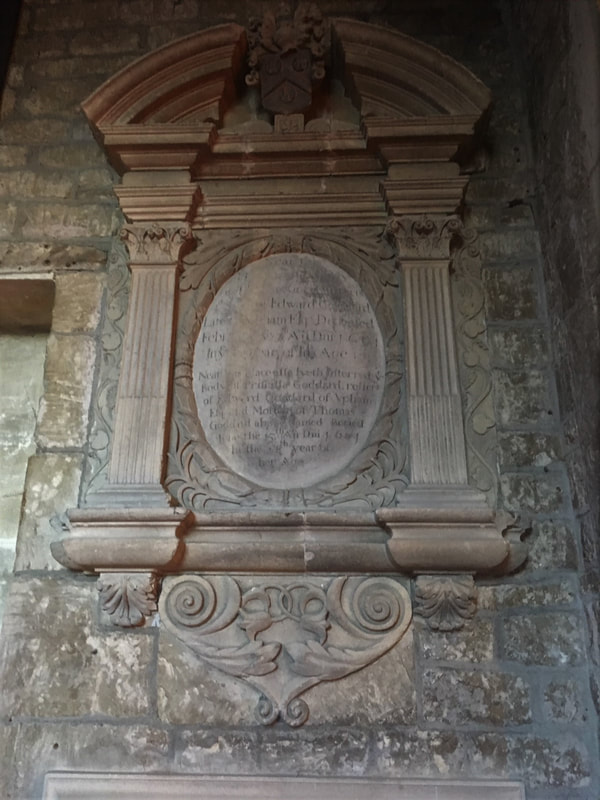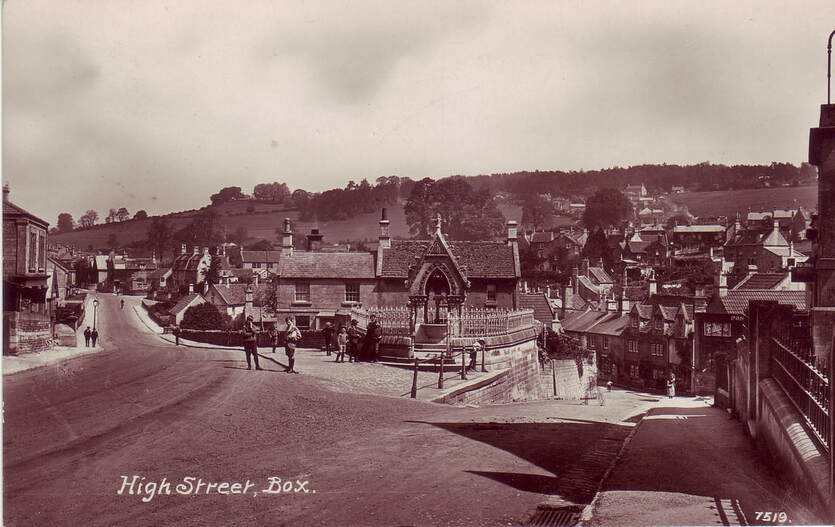The Poynder Fountain Alan Payne January 2022
The fountain for horses and people at the centre of Box village has always been called the Poynder Fountain. It is a Grade II listed Historic Building built in 1877-78 by William Henry Poynder. Made of pink and grey granite with rich carving and an ornate canopy, views about its merit vary between hideously vulgar to a Gothic masterpiece but all agree it is a notable exception.
Little has previously been recorded about the structure and, to get the situation into context, we need to start earlier with the Goddard family of Rudloe.
Goddard Family
The Goddard family were wealthy land-owners and well established in Wiltshire from the late 1400s. They were a large family derived from Thomas Goddard of Upham who bought their power base and the lordship of the manor of Swindon in 1563 where their estate is now called The Lawns. In the 1800s various members of the family served as Member of Parliament for Cricklade.
Little has previously been recorded about the structure and, to get the situation into context, we need to start earlier with the Goddard family of Rudloe.
Goddard Family
The Goddard family were wealthy land-owners and well established in Wiltshire from the late 1400s. They were a large family derived from Thomas Goddard of Upham who bought their power base and the lordship of the manor of Swindon in 1563 where their estate is now called The Lawns. In the 1800s various members of the family served as Member of Parliament for Cricklade.
The family owned various properties in Box, mostly in Rudloe and in the east of the parish. They began to acquire property in the area in the 1600s and Thomas Goddard (died 1691) rebuilt Rudloe Manor House about 1685.[1]
|
The family’s name has many Georgian references in Box. In 1701, the estate of another Thomas Goddard sold Chapell Fields for £20.5s; in 1719 Ambrose Goddard was active as a trustee of the Box Charity School assisting Rev George Millard; and in 1736 Ambrose Goddard, Gent, was mentioned as one of only eleven people qualified as a freeholder of land in Box.
In the chancel of Box Church is a large family monument to the Goddards. The memorial reads: Near this place lyeth the body of Thomas Goddard Gent 4th son of Edward Goddard late of Upham Esq deceased February the 7th AD 1691 in the 71st year of his age. Near this place also lieth interred the body of Priscilla Goddard relict of Edward Goddard of Upham Esq and mother of Thomas Goddard above named buried June 15th AD 1681 in the 88th year of her age.[2] A memorial brass plaque can be found in Box Church for Thomas Goddard of Rudloe (1660-1703). It reads: Here lyeth buried Thomas Goddard of Rudlow Esq who to the great grief of his neighbours and loss of his family dyed the 24th of September 1703 in the 44th year of his age. Richard Jefferies, a Victorian historian, recorded the history of the family in North Wiltshire, asserting that Edward was the second son of Richard Goddard of Upham. Edward married Priscilla D’Oyley and their son Thomas (1620-91) lived at Box and grandson also Thomas lived at Rudloe with his wife Mary Awdry.[3] |
Poynder Family Involvement
Another branch of the Goddard family acquired Hartham Park, just east of Rudloe which they owned from at least 1640.[4] The family bought Drewetts Mill in the 1830s presumably intending to expand in the area but it didn’t turn out like that. For a brief period, Henry Hall Joy, a London barrister, owned the estate and, after his death in 1840, it was sold it to Thomas Henry Allen Poynder in the 1850s.
THA Poynder was a keen supporter of the Wiltshire Rifle Volunteers for over 10 years offering 30 guinea prizes for leading marksmen and entertaining officers to sumptuous meals comprised of turtle soup, turbot and venison washed down with champagne.[5] He was a great public benefactor who donated considerable funds to worthy local causes. These included prizes for the annual Colerne ploughing competition, subscriptions for the restoration of the nave of Bristol Cathedral, fund for the restoration of Christian Malford Church, patronage of the New Hall Chippenham and supporter of the Wiltshire Discharged Prisoner’s Aid Society.[6] The wealth of the family was shown by the funeral cortege of his wife.[7] A procession of two mutes (sic), followed by a plumed hearse drawn by four horses, three mourning carriages and three private carriages. From Hartham the cortege processed to Chippenham where it was preceded by a company of fifty-six members of the Chippenham Volunteers, then to Calne, Hilmarton and back to Hartham for internment.
On the death of Thomas Henry Allen in 1873, the estate passed to his brother William Henry Poynder, the man who donated the Poynder fountain four years later. WH Poynder was High Sheriff of Wiltshire, Corsham magistrate and a trustee of the Chippenham Workhouse (now St Andrews Hospital) to whom he regularly donated two roast beef meals on Christmas and New Years Days. Out of gratitude in 1876-77, inmates reputedly wrote mottoes on the wall God save the Queen and Health and Happiness to Mr WH Poynder.[8] Jacob Phillips, the agent for the Poynder family in the absence of family members, reminded inmates that New Years Day was an occasion when rich and poor endeavoured to enjoy themselves and the idea entertained by many people that they were forgotten was altogether a wrong idea. He also entreated them to do their duty in that station in life in which they had been placed.
We can speculate that the gift of the Box Fountain was a statement that WH Poynder had arrived in the area with the family coat-of-arms engraved in the top of the structure. But there is more to it than just a Poynder gift. WH Poynder didn’t make the gift alone and the trustee of the Northey Box lands, Colonel Edward Richard Northey of Woodcote, organised the piping of spring water into this area of the village from Ashley, without which the fountain would have been irrelevant. This was followed by the development of residential properties along the road now called A4 up on Box Hill.
Another branch of the Goddard family acquired Hartham Park, just east of Rudloe which they owned from at least 1640.[4] The family bought Drewetts Mill in the 1830s presumably intending to expand in the area but it didn’t turn out like that. For a brief period, Henry Hall Joy, a London barrister, owned the estate and, after his death in 1840, it was sold it to Thomas Henry Allen Poynder in the 1850s.
THA Poynder was a keen supporter of the Wiltshire Rifle Volunteers for over 10 years offering 30 guinea prizes for leading marksmen and entertaining officers to sumptuous meals comprised of turtle soup, turbot and venison washed down with champagne.[5] He was a great public benefactor who donated considerable funds to worthy local causes. These included prizes for the annual Colerne ploughing competition, subscriptions for the restoration of the nave of Bristol Cathedral, fund for the restoration of Christian Malford Church, patronage of the New Hall Chippenham and supporter of the Wiltshire Discharged Prisoner’s Aid Society.[6] The wealth of the family was shown by the funeral cortege of his wife.[7] A procession of two mutes (sic), followed by a plumed hearse drawn by four horses, three mourning carriages and three private carriages. From Hartham the cortege processed to Chippenham where it was preceded by a company of fifty-six members of the Chippenham Volunteers, then to Calne, Hilmarton and back to Hartham for internment.
On the death of Thomas Henry Allen in 1873, the estate passed to his brother William Henry Poynder, the man who donated the Poynder fountain four years later. WH Poynder was High Sheriff of Wiltshire, Corsham magistrate and a trustee of the Chippenham Workhouse (now St Andrews Hospital) to whom he regularly donated two roast beef meals on Christmas and New Years Days. Out of gratitude in 1876-77, inmates reputedly wrote mottoes on the wall God save the Queen and Health and Happiness to Mr WH Poynder.[8] Jacob Phillips, the agent for the Poynder family in the absence of family members, reminded inmates that New Years Day was an occasion when rich and poor endeavoured to enjoy themselves and the idea entertained by many people that they were forgotten was altogether a wrong idea. He also entreated them to do their duty in that station in life in which they had been placed.
We can speculate that the gift of the Box Fountain was a statement that WH Poynder had arrived in the area with the family coat-of-arms engraved in the top of the structure. But there is more to it than just a Poynder gift. WH Poynder didn’t make the gift alone and the trustee of the Northey Box lands, Colonel Edward Richard Northey of Woodcote, organised the piping of spring water into this area of the village from Ashley, without which the fountain would have been irrelevant. This was followed by the development of residential properties along the road now called A4 up on Box Hill.
The fountain was partly an epitaph to the donors as Colonel Northey died in the year of its completion and William Henry Poynder died two years later in 1880. The structure was in private hands for many years and had become rather run down with the ornate railings around it removed during the Second World War to be recycled for armament purposes. It was acquired by the parish council in 1980, who have replaced the railings and kept the centre piece of the village in good repair since then.[9]
Conclusion
The building of the Poynder fountain was a decisive moment in the village’s development. As such, it was built to be different and symbolically important. The use of the water fountain to refresh people and horses before the arduous climb up Box Hill didn’t survive the motor age but the position of the fountain has endured as the start of a speculative development in the east of the village.
Rudloe never had its own church which was the reason that the Goddard family frequented Box Church. The religious connection continued. The fountain was a way of contributing to the religious needs of the area through the education of children in the Church of England Box Schools built in 1875. The school needed water for drinking, cleaning and lavatories. The water supplied for the fountain also supplied the needs of the school. In addition, it opened the opportunity to build houses to the east of the village. The morally-worthwhile charitable donation of the Northeys and Poynders facilitated the building of properties along the London Road which were financially lucrative for both families. There’s a lot more of Box’s history in the Poynder Fountain than just a quirky historic structure.
Conclusion
The building of the Poynder fountain was a decisive moment in the village’s development. As such, it was built to be different and symbolically important. The use of the water fountain to refresh people and horses before the arduous climb up Box Hill didn’t survive the motor age but the position of the fountain has endured as the start of a speculative development in the east of the village.
Rudloe never had its own church which was the reason that the Goddard family frequented Box Church. The religious connection continued. The fountain was a way of contributing to the religious needs of the area through the education of children in the Church of England Box Schools built in 1875. The school needed water for drinking, cleaning and lavatories. The water supplied for the fountain also supplied the needs of the school. In addition, it opened the opportunity to build houses to the east of the village. The morally-worthwhile charitable donation of the Northeys and Poynders facilitated the building of properties along the London Road which were financially lucrative for both families. There’s a lot more of Box’s history in the Poynder Fountain than just a quirky historic structure.
References
[1] Courtesy Julian Orbach from his unpublished research to update Pevsner Architectural Guide to Buildings of England: Wiltshire
[2] Text courtesy Charles Freeman
[3] Richard Jefferies, A Memoir of the Goddards of North Wilts, 1873, p.33
[4] Richard Jefferies, A Memoir of the Goddards of North Wilts, 1873, p.41
[5] Devizes and Wiltshire Gazette, 25 August 1870
[6] Bath Chronicle and Weekly Gazette, 7 August 1873 and 20 October 1870, Devizes & Wiltshire Gazette, 5 May 1870, and Salisbury and Winchester Journal, 7 May 1870
[7] Bath Chronicle and Weekly Gazette, 2 November 1871
[8] The Bath Chronicle, 4 January 1877
[9] Wiltshire Times and News, 7 March 1980
[1] Courtesy Julian Orbach from his unpublished research to update Pevsner Architectural Guide to Buildings of England: Wiltshire
[2] Text courtesy Charles Freeman
[3] Richard Jefferies, A Memoir of the Goddards of North Wilts, 1873, p.33
[4] Richard Jefferies, A Memoir of the Goddards of North Wilts, 1873, p.41
[5] Devizes and Wiltshire Gazette, 25 August 1870
[6] Bath Chronicle and Weekly Gazette, 7 August 1873 and 20 October 1870, Devizes & Wiltshire Gazette, 5 May 1870, and Salisbury and Winchester Journal, 7 May 1870
[7] Bath Chronicle and Weekly Gazette, 2 November 1871
[8] The Bath Chronicle, 4 January 1877
[9] Wiltshire Times and News, 7 March 1980



